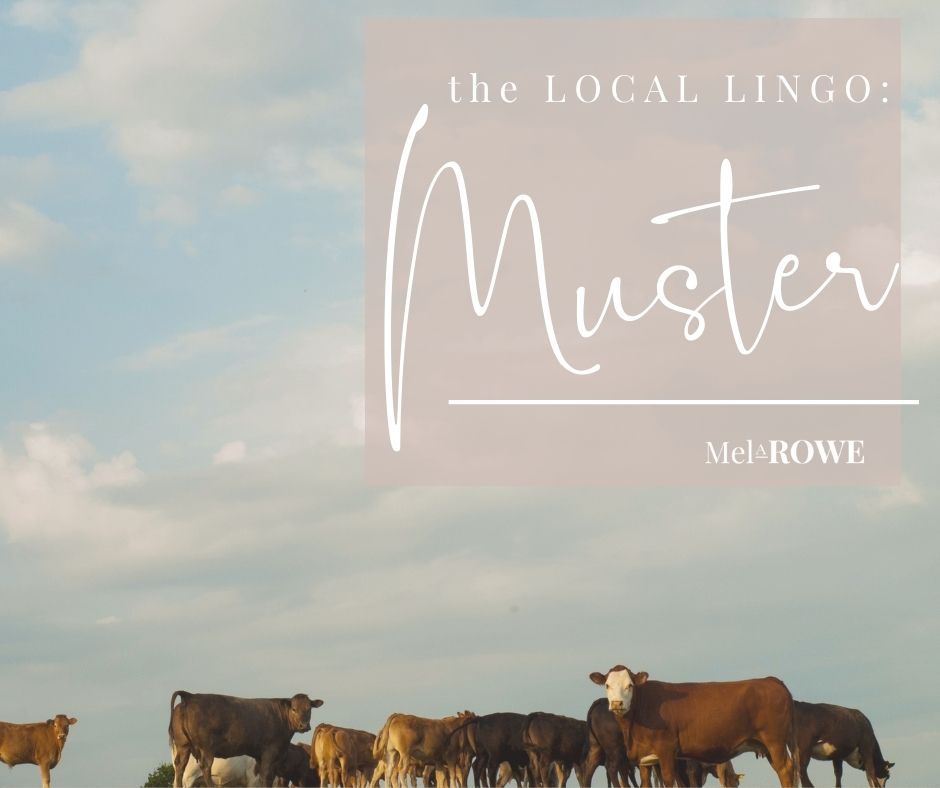
For those who were too afraid to ask, this is about the word muster, and cattle mustering in Northern Australia.
Oh, as poor-taste puns do occur, so for those who may be lactose intolerant may need to moo-ve along.
The Dictionaries say muster is
Muster is to gather, summon, rouse. It’s also a term to round up, roll call, to do a head or nose count, to group, draft and rally, assemble, crowd, meet and just gather.
Did that just go through one ear then out the udder!
So let’s raise the steaks shall we…
There’s the Military Muster
Military muster where the troops gather for inspections is also known as ‘a call to muster.’
Muster in is to be enlisted in military service
Muster out is the opposite, which is to get a discharge from military service
To pass Muster
Such a common term that amooses many who have herd it!
But it’s a legen-dairy term!
To pass the muster is to be judged and found to be acceptable.
Another common term that I herd the udder day was : to Muster the courage.
Do I stop with this udder nonsense before you stampede for the door?

The Great Outback Cattle Muster
No bull about it, but the cattlemen’s muster is a beefy ordeal!
Basically, a muster is herding cattle on cattle stations. There, that’s it.
Hold your horses, we’re not done yet.
The Northern Australia Muster Season
As they perform musters on cattle stations (that are massive farms), and like most things to do with farming it involves the weather.
In the Northern Territory, there are two seasons, the wet and dry seasons.
The wet season runs between November/December to March/April where a tonne of monsoonal rain pretty much drenches the land, turning it into an inland sea. It’s summer.
The dry season is simply months of no rain. That’s winter.
The mustering season kicks off after the wet season when it’s dry enough for trucks to moo-ve around without getting stuck in the mud! (Bogged.)
Why muster?
The aim of doing a cattle muster is to herd cattle together to conduct health checks, vaccinations, draft (sort) cows into categories, conduct pregnancy testing, draft weaners (brand, desex the males, vaccinate and tag calves), bulls are removed, swapped, dependent upon the stations breeding programmes.
It’s hard hot work. And there’s nothing quite like swallowing and snorting cattle dust as part of your day job, just don’t get me started on the flies!
Technicalities of a cattle Muster – made simple!
Of course, every station is different with their terms and techniques, so this is only offered as general information written to amoose you.
Musters are done using water, like a dam (turkey nests) that attracts the cattle to that area. A helicopter, followed by ag bikes pushes the cattle toward the main herd.
Stock horses are then used to control the speed as they keep the cattle calm gently pushing the herd along, letting the cattle walk at their own pace. This is to not spook the young cattle and cleanskins (unbranded/unmarked feral beasts).
So, as a mob (herd) they’re walked towards the yards for drafting. On the long walk, more cattle are flushed out from the scrub by the choppers where they are fed into the mob. Many refer to this as the coacher muster. The coachers are the educated (experienced) cattle who mix with the bush (feral) cattle. These coachers are there to teach those newbies how to behave in a herd. It doesn’t take long for them to gain a sense of belonging to become part of a collective herd.

Muster teams on the run
The mustering teams consist of a head stockman/woman, ringers, a Boreman, camp cooks, a Jackeroo or Jillaroo and truck drivers. Depending on the station, the mustering team will go outback for weeks at a time – way beyond mobile phone range. They all come with a certain amount of stock sense in being able to read the herd, to know not to push cattle too hard or fast but to keep everyone calm.
The basic job of the team running the herd are:
A horseman leads the herd while monitoring the bullies and ratbags who try to take a break for the bush.
The sucker on the tail-end monitors younger calves while keeping the stragglers together.
The buggy and bikes are usually running on the wings of the mob.
Choppers and bikes bring in the stragglers that are then fed (coached) into the mob.
Planes are for spotting cattle and will alert the muster teams by radio.
Muster team member titles & general terms:
Depending upon where you are titles may vary
Stockcamp —this is where the stock workers will stay in a makeshift camp as some musters are held days away from the cattle station’s main homestead. It’s also a term for a collective group of workers.
Boreman—Water is a necessity in the outback and their job is to check the water bores and dams are clear to drink. They’re also knowns as borerunners or boundary riders as they check the boundary fences as part of their bore runs.
Camp cook—yes, as the term states they do the cooking, but the camp cooks also feed the weaners, drives the trucks or mans the sticks in the yards, meaning they’ll do more than just cook.
Chopper pilots—cheeky bastards who wing it from the air. Pilots, what can I tell you.
Horse camp— where stock horses are kept together and managed by a horse tailor. But these days horse care is usually up to the ringer to maintain themselves.
Ringers — are also known as Stockmen or stockwomen – the workers, some answer to drovers.
Jillaroo / Jackeroo—the apprentices, also known as a green ringer.
Head Stockmen or stock women—the boss or 2IC to the Station Owner/ Manager.
Station hand—is a farmhand who usually does stock work, fencing, and pastoral work.
The argument of Cowboys Versus Cattlemen when mustering
As Aussies the mustering team are only called cowboys when acting like… well, boys. Some consider it an insult, as is the case in The STATION.
A cattleman is a cattle breeder or a station owner, like a rancher. They are not to be confused with farmers who are known as Cockies or Cocky.
The Long walk:
The aim of the walk is to keep cattle calm as they move in a herd. It’s long hours, with denim bums on leather saddles or bike seats, swallowing dust and swatting at flies as you follow endless fence lines under a gi-normous sky.
(*Hot tip, never mention fly nets to a ringer—they’re too tough for that!)
It’s long hours, with denim bums on leather saddles or seats, swallowing dust and swatting at flies
The Muster’s Goal:
The muster’s aim is to get the cattle yarded up and then drafted.
Yarding:
Done by the walk, they’re pushed from the paddocks down the fenced laneways and into the cattle yards where they are drafted.
Drafting:
Not drafting for the army, but it’s where the cattle are classed, branded, and sorted through a series of gates or fences (also known as manning the sticks).
The groups are based on classes of cattle, lactating cows and calves, ‘dry’ cows, weaners. Cattle chosen for sale are processed to be trucked to sale yards or for agistment.
As for the cows and calves, they are held back after the drafting to mother-up before they are walked out of the yard and onto the grass.
Thousands can pass through these yards in a matter of days.
Stations usually do a couple of muster rounds per season.
Mustering is dangerous!
Mustering may seem romantic, but it has its dangers too.
Cattle stations are remote locations where in case of emergencies it can take half a day for some serious rescue missions.
Ringers work within an unpredictable environment of long hot days under an outback sun so they deal with risks of dehydration. But they also deal with the unpredictability of cows and horses, not to mention the wildlife that lurks around like snakes.

Then there are the other animal musters:
Horse musters
There are showjumping or community equestrian events that are called musters.
Feral Muster
These are culling programmes set to maintain numbers of feral stock in certain regions. Handling processes of mustered animals are done in a humane way to also ensure the environmental impacts of mustering are minimised. Much effort is made to re-home certain animal species from these musters.
Sheep musters
I know nothing about sheep musters as there are no sheep in the Northern Territory. Can you imagine wearing all that wool up here in the summer?
Dog Musters
In Casterton in Victoria, the ‘Birthplace of the iconic Australian Kelpie, they hold an annual muster where they show these dogs amazing skills in a set of tests.
It’s also an auction where these Aussie working dogs can fetch prices up to $20,000
More musters:
The Bangtail Muster
Since 1959, in Central Australia, The Bangtail Muster is a community event (dance, and street parade) to signify the traditional start of the mustering season. The Bangtail Muster name came from the stockman’s tradition of cutting the ends of the tail to count the cattle they’d mustered.
Ute musters—Events where people show off their utes. The TopEnd holds an annual ute muster on Australia Day and the most famous ute muster is the Deni Ute Muster.
Moo-sic musters— are very common. The Gympie Music Muster has been going for 40 years.
A Famous Man named Muster—Thomas Muster is a former world No1 Tennis player who used to call Australia home.
The Muster shoe — is a traditional Derby shoe. Not recommended for wearing at riji-dig cattle musters, but more for a steak date.
A muster drill on a Royal Caribbean cruise ship is a mandatory exercise held prior to departure. It’s help guests and crew know where to assemble in cases of an emergency. It’s like a fire drill on a luxury ship. Cocktail glasses and sunscreen is a given.
The Mobile Muster—where people can recycle their old mobile (cell) phones.
Drum Musters —A National program to collect and recycle or safely dispose of chemical containers used by farmers.
Mining Muster Points —places where miners meet in case of fire and emergencies and where they hold their union meetings. Most Government buildings have the same. It’s usually a big green sign.
The NT POLICE Shift Muster—where the GD’s (General Dusty Officers) meet at the beginning of each shift to discuss the latest occurrences etc. Just like the military above.
Muster Rooms – a place to gather, like a staff room. In THE STATION, the Muster room is where the cattlemen, ringers, cheeky chopper pilots, Jackeroos, have their meals and generally hang out after hours.
Lastly, I bet you didn’t know a muster is also the term for a flock of peacocks.
So why this blog post about the Muster?
Many of my readers have asked me about mustering, and because I wrote a book titled:
Ta-da…
MUSTER IN THE DUST!
Guess what it’s about?
And if you want to get a peek at station living during a muster season, check out
THE STATION.
Go on, you’ve made it this far. Take a moment for yourself to flop onto the couch and download any of these books as your next great escape into a Happily Ever After.

Feel Free to Pin



**All still images relating to this post’s topic are via the talented & fabulous photographers at https://unsplash.com/ Thanks guys.
**DISCLAIMER: This blog post may contain affiliate links that is at NO cost to you!
_________________________________________
#Escape2HEA ~ because everyone deserves an Escape from the drama in their day!
| #ElsieCreek | #ArtofDUST | #DiamondintheDUST | #CakedinDUST | #XmasDUST | #MusterintheDUST












